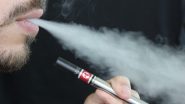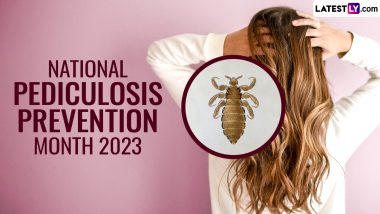National Pediculosis Prevention Month, also known as Head Lice Prevention Month, is observed in September yearly. This dedicated month highlights the importance of preventing and managing head lice infestations. Let's delve into what pediculosis is and why this awareness month matters. Oldest Known Sentence in History Written in Earliest Alphabet Discovered in Archaeological Dig; Inscription Carved Into Ivory Comb Warns About Head Lice (See Pic).
Understanding Pediculosis: What is it?
Pediculosis refers to an infestation of parasitic insects known as lice. The most common type affecting humans is head lice, tiny insects that attach themselves to the hair and feed on human blood. While head lice are not dangerous and don't spread diseases, they can cause discomfort, itching, and social stigma.
Why National Pediculosis Prevention Month Matters
Education and Awareness: This awareness month educates people about the signs, symptoms, and prevention of head lice. You can take proactive measures to protect yourself and your loved ones by being informed.
De-Stigmatization: There is often a stigma associated with head lice infestations. National Pediculosis Prevention Month aims to reduce this stigma and foster empathy and understanding.
Early Detection: Learning about the signs of head lice allows for early detection and timely treatment. Early action can prevent the infestation from spreading to others.
Prevention: Prevention is key when it comes to head lice. National Pediculosis Prevention Month provides information about effective preventive measures, such as avoiding sharing personal items like combs, hats, and headphones.
How to Prevent Head Lice
Regular Checks: Conduct regular head checks, especially for children, to detect head lice early. Pay attention to itching, redness, or small white eggs (nits) attached to the hair shafts.
Educate Children: Teach children about the importance of not sharing hats, combs, brushes, and other personal items that come into contact with the hair.
Hair Care: Encourage tying hair back in ponytails or braids, which can reduce the risk of lice transfer.
Notify Others: If you discover head lice in your family, notify close contacts, such as friends and school, so that they can also take preventive measures.
Use Preventive Products: There are over-the-counter products like shampoos and conditioners that contain essential oils or other ingredients known to deter lice.
Clean Beddings and Clothing: Wash beddings, pillowcases, and clothing that may have come in contact with the infested person.
Professional Help: If infestations persist, consult a healthcare professional or a qualified specialist for guidance and treatment.
National Pediculosis Prevention Month serves as a reminder that head lice can affect anyone, regardless of age or background. By being proactive, informed, and supportive, we can prevent and manage head lice infestations while creating a more understanding and compassionate community.
(Disclaimer: This article is written for an informative purpose and should not be substituted for medical advice. Kindly consult your doctor or professional nutritionist before trying any tips.)
(The above story first appeared on LatestLY on Sep 03, 2023 07:06 PM IST. For more news and updates on politics, world, sports, entertainment and lifestyle, log on to our website latestly.com).













 Quickly
Quickly




















